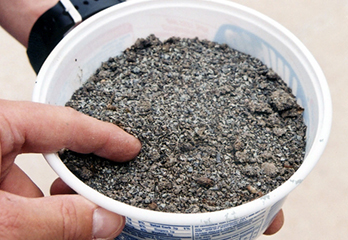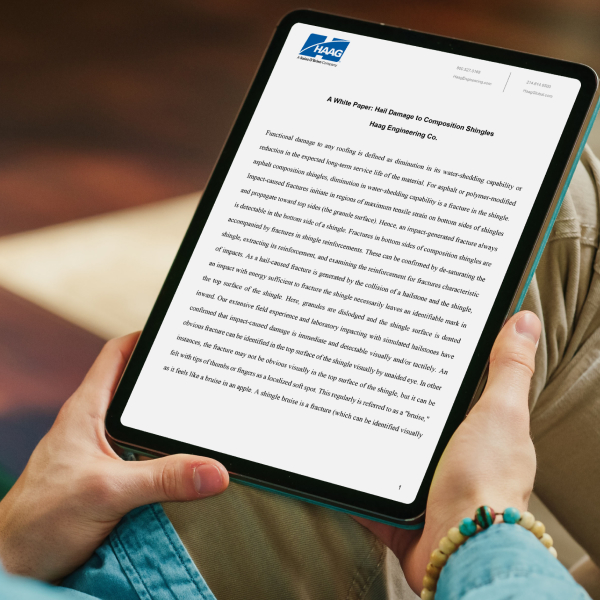Hail Strikes & Granule Removal
Composition roofing, also known as asphalt shingle roofing, works well in a variety of climates and is relatively inexpensive. It is the most common residential roofing material used in the United States.

Composition shingles are made of three components: a reinforcement (most commonly made of fiberglass, but sometimes made of organic felt), a water-proofing binder (asphalt or sometimes polymer-modified asphalt), and a surfacing of granules.
The granules (mostly ceramic-coated rock fines, but sometimes crushed stone) serve several purposes. Not only do they protect the binder from sunlight, but they add color and weight, reflect heat, and provide fire resistance. About one-third of the weight of an asphalt composition shingle is granules. Thus, for a 210 pound-per-square composition roof, there are about 70-80 pounds of granules per square, or more than a ton of granules on a single 30-square roof.
Does the Impact of a Hailstone Cause Granule Removal?
As asphalt shingles age, their components break down. The extent of aging depends upon many factors, such as the quality of the asphalt, shingle color, roof pitch, slope direction, and attic ventilation. Other influences include the quality of the installation and maintenance as well as the weather to which the shingles are exposed. The granules are the wearing surface for the roofing and the loss of granules from asphalt shingles is expected over time.
But what role does hail play? As noted within the pages of Haag’s Composition Roofs Damage Assessment Field Guide, the short answer is that, yes: the impact of a hailstone may dislodge granules from the shingle. But, importantly: it is highly unlikely that hailstone impacts which do not fracture or rupture the shingle reinforcement will cause significant granule loss. This is because the granules which are lost from smaller hail normally do not expose unprotected binder to the elements. More granules are initially placed on the shingles than are needed to protect the asphalt bonded to the reinforcement. Normally, the granules dislodged by a hail strike are the “hitchhikers”, those pinched between other granules which are bonded to the asphalt.
Think about the life cycle of tires on a vehicle, to which granule loss may be likened. Over the life of a tire, rubber is lost continually. A sudden stop reduces the amount of rubber by an insignificant amount and is expected. A hailstorm, likewise, is an expected event and does not significantly reduce the amount of granules.
Haag Studies on Granule Removal
In order to determine how many granules, if any, must be removed in order to affect the service life or water shedding ability of the shingle, Haag engineers conducted a granule loss study on asphalt shingles. Varying quantities of granules were removed with a wire brush from new, three-tab, fiberglass shingles.
The shingles then were exposed to the weather in Dallas, Texas, for ten years. The quantities of granules removed were none (control), and approximately 6, 15, 45, and 70 percent of the total granules on the shingles. Another shingle was installed upside down such that the asphalt was exposed to the weather. The shingles were installed conventionally over underlayment on an open plywood deck at a 4:12 pitch that faced south. The shingles were examined at intervals throughout the ten-year period as well as at the conclusion of the study.
In one year, the exposed asphalt had oxidized gray but there was no visible evidence of surface cracks or erosion. After five years, areas of exposed asphalt had oxidized but this did not affect the function of the shingles to shed water. Surface erosion was visible on the shingle without granules, and some of the fiberglass had become exposed. After ten years, no significant change was noted in the shingles except for the shingle without granules. More fiberglass was exposed on this shingle due to erosion; but, the shingle continued to shed water.
The quantity of granules lost from the roof shingles during a hailstorm is a relatively small amount. Based on our laboratory experience of making impacts with simulated hailstones in the lab, and as confirmed by thousands of Haag roof inspections, the shingle reinforcement is fractured before a significant amount of granules are removed by hail.
Scott Morrison, P.E., Director of Haag Research/Testing lab
Scott Morrison specializes in Structural Evaluations, Foundations, Earthborne and Airborne Vibrations, Roofing Systems, Reconstruction Monitoring and Analysis, Research/Testing, and Architectural. He is a primary author of material in the Haag Certified Inspector courses and many of the Haag Damage Assessment Field Guides.

